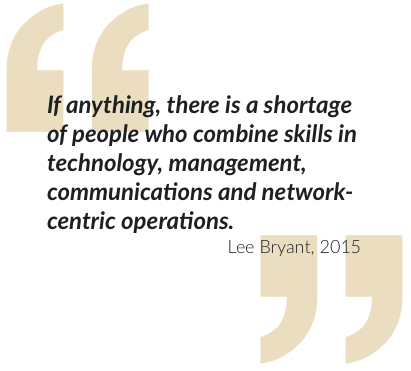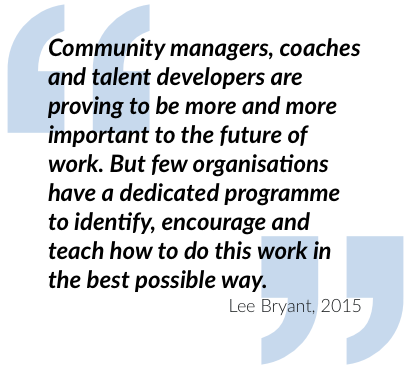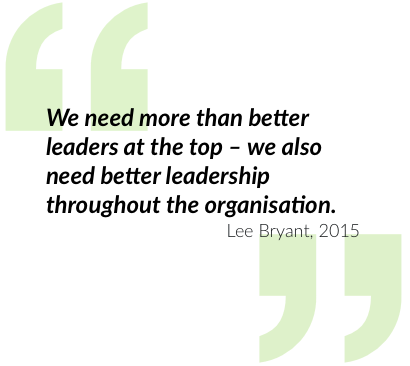Change Agents
Digital Workplace Futures
One of the hardest won lessons of the digital workplace journey has been that those responsible for its success cannot achieve it alone – it takes a village. There is a small percentage of change that can be owned, and some can be managed or mandated, but the vast majority must be achieved through influence. The larger the firm, the harder the becomes.
The earliest attempts to directly involve users in adoption focused on ensuring every business unit had a super user knowledgable about the features of the platform.
Another early approach, especially for professional and financial services firms to spin up an internal consulting team. They could support important use cases and workflows through the process of transition. A small number of firms invested heavily in larger networks of digital passionate, and this model went from strength to strength.
The next shift emerging in small pockets focuses on the democratising of change across the whole organisation – an agenda item for all.
> Introduction
> Technology
> Ownership
> Community
> Design
> Collaboration
> Skills
> Change Agents
> Leadership
> Org Structure
> Measurement
> Conclusion
- SHIFT 1: Super Users
- SHIFT 2: Internal Consultants
- SHIFT 3: Digital Guides
- NEXT: Democratised Change
- SHIFT 1: Super Users
Most organisations achieved high activity during and straight after their roll-out. But then inevitably usage stats dropped and questions were asked about the tactics used. Engaging launch campaigns and tools training were evidently not enough – teams needed more in-depth, specialist help in applying digital technology to transform their ways of working.
Super user networks were a common feature of all large change management programmes owned by IT. They were rarely given sufficient training, or any air cover to truly change the way people worked. Their contributions were often under-valued and squeezed into a small percentage of their overall role. In many cases, the same employee was the super user on multiple systems, leading to change fatigue.
- SHIFT 2: Internal Consultants
One popular response was to create dedicated internal consulting functions to work directly with teams. They focused on finding and designing key use cases that would help the organisation achieve new levels of productivity, efficiency and effectiveness. They took a design-led approach to use case design, considering how information flowed, how it was owned, how the use case might be made sticky with particular teams and crucially, how they might measure its success.
This approach was extremely targeted and successful, bringing to life the potential of digital tools in real work scenarios. As the consulting team was internal, they were already known and trusted by the business, although often learned the tools ‘by the book’, lacking digital fluency themselves. This led to a trend of templating communities and cookie-cutter use cases applied to multiple teams without examining the in-depth user behaviour that could make them fail.
However, this type of dedicated resource is an expensive way of embedding change. Many companies didn’t have the appetite or budget for supporting this model over the long-term.
- SHIFT 3: Digital Guides
The most successful organisations are realising that digital guides – those passionate individuals identified as intrinsically motivated to help the organisation change – need to be cultivated more systematically and nurtured to fulfil their potential. Being a change agent can be a lonely, thankless task so support both inside and outside the organisation is essential. Organisations must as a basic requirement teach them how to identify use cases and design more transformational work practices, in a peer-to-peer learning community.
This approach also ensures that these important skills are not relegated to invisible labour, done in the gaps of an existing day job, and are instead recognised as a key component of supporting the organisation in building their future.
Some of the early change agents have now risen up the ranks of their organisations based on the results they achieved in stealth mode. This new style of leadership can only help accelerate the rate of organisational transformation.
A2 #PS_Salon – Aha moments over and over whenever I see the great engagement of our @DigitalLife_DAI multiplier #netWork around the globe. Smart colleagues who support us in spreading digital workplace tools, skills & mindset 🚀 #digitalUs
— Lukas Fütterer // @lukizzl@mastodontech.de (@lukizzl) April 5, 2019
- NEXT: Democratised Change
Change agents are by nature always looking for what comes next. Their biggest impact on the organisation is showing that everyone has a voice, and everyone has a role in shaping the future. This democratisation of change is truly the only way adaptiveness will become embedded to enable organisations to cope with the demands of the 21st century.
Once a supporting community-based infrastructure to attract, develop and enable digital guides has taken root, you will have built a pool of emerging leaders who understand what is required to mobilise adaptive teams. Where these leaders go, others will follow, driving transformation at an accelerated pace.
If we can support change agents by creating a toolkit and a management system for ongoing change that puts control in the hands of the individual teams and managers who want to improve their area of operations we can enable organisations to become emergent and evolutionary. Change agents are no longer the canaries in the coal mine, but form a human sensor network nudging the organisation towards the future.



